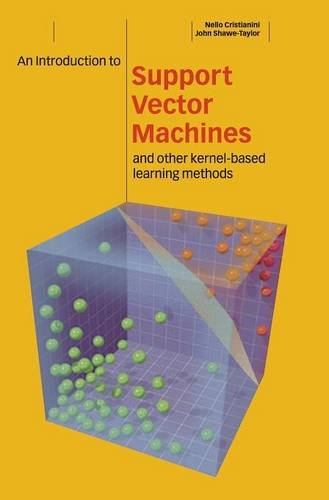An Introduction to Support Vector Machines and Other Kernel-based Learning Methods pdf
Par henry anthony le samedi, mars 25 2017, 14:41 - Lien permanent
An Introduction to Support Vector Machines and Other Kernel-based Learning Methods. John Shawe-Taylor, Nello Cristianini

An.Introduction.to.Support.Vector.Machines.and.Other.Kernel.based.Learning.Methods.pdf
ISBN: 0521780195,9780521780193 | 189 pages | 5 Mb

An Introduction to Support Vector Machines and Other Kernel-based Learning Methods John Shawe-Taylor, Nello Cristianini
Publisher: Cambridge University Press
The book is titled Support Vector Machines and other Kernel Based Learning methods and is authored by Nello Cristianini and John-Shawe Taylor. This is the first comprehensive introduction to Support Vector Machines (SVMs), a new generation learning system based on recent advances in statistical learning theory. Introduction:- A data warehouse is a central store of data that has been extracted from operational data. According to Vladimir Vapnik in Statistical Learning Theory (1998), the assumption is inappropriate for modern large scale problems, and his invention of the Support Vector Machine (SVM) makes such assumption unnecessary. Machines, such as perceptrons or support vector machines (see also [35]). It too is suited for an introduction to Support Vector Machines. Shawe-Taylor, An introduction to sup- port vector machines and other kernel-based learning methods (Cambridge: Cambridge University Press, 2000). A Research Frame Work of machine learning in data mining. Those are support vector machines, kernel PCA, etc.). Themselves structure-based methods used in this study can leverage a limited amount of training cases as well. Introduction The support vector machine (SVM) proposed by Vapnik [1] is a powerful methodology for solving a wide variety of problems in nonlinear classification, function estima- tion, and density estimation, which has also led to many other recent developments in kernel-based methods [2–4]. Search for optimal SVM kernel and parameters for the regression model of cadata using rpusvm based on similar procedures explained in the text A Practical Guide to Support Vector Classification. Data in a data warehouse is typically subject-oriented, non-volatile, and of . Several experiments are already done to learn and train the network architecture for the data set used in back propagation neural N/W with different activation functions. Shawe, An Introduction to Support Vector Machines and other Kernel-based Learning Methods, Cambridge University Press, New York, 2000. Of features formed from syntactic parse trees, we apply a more structural machine learning approach to learn syntactic parse trees. This demonstrates that ultrasonic echoes are highly informative about the Cristianini N, Shawe-Taylor J (2000) An introduction to Support Vector Machines and other kernel based learning methods. We used a standard machine learning algorithm (SVM) to automatically extract suitable linear combinations of time and frequency cues from the spectrograms such that classification with high accuracy is enabled. Instead of tackling a high-dimensional space. [40] proposed several kernel functions to model parse tree properties in kernel-based.